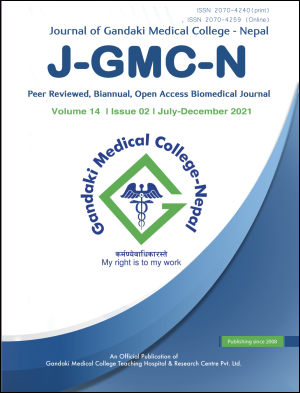Functional outcome among patients treated by percutaneous cannulated screw with tension band for transverse patella fracture
DOI:
https://doi.org/10.3126/jgmcn.v14i2.38937Keywords:
Patella fracture, Cannulated screw, percutaneousAbstract
Introduction: Tension band wiring is the most commonly used treatment method for transverse patella fracture. Tension band construct can be achieved by various modifications. Percutaneous cannulated screw with tension band is a minimally invasive technique with stiffer fixation that follows tension band principle. This study aims to assess the clinical and radiological outcome using percutaneous cannulated screw with tension band for the management of transverse patella fracture.
Methods: This was a prospective study among 30 adult patients who had closed displaced transverse patella fracture. Patients with polytrauma, comminuted fracture, neurovascular injury and prior injury to the limb were excluded from the study. Each patient was followed up at 2 weeks, 4 weeks, 3 months and 6 months postoperatively.
Results: Among all surgically treated patients using this technique, Pain gradually decreased over time and was less than VAS score of 1 in all patients at 6 months follow-up with an average score of 0.3. The final range of motion at 6 months was: flexion ranging from 122 to 145 degrees and extension lag from of 0 to 8 degrees. There was significant improvement in range of motion of knee in each follow up. The mean duration for fracture union was 11.4±2.3 weeks. There were no cases of nonunion and hardware failure. The mean Lyshom score was 82.5 at final follow up.
Conclusions: The percutaneous fixation of transverse patella fracture with cannulated screw and SS wire is safe and effective method which gives good functional outcome.
Downloads
Downloads
Published
How to Cite
Issue
Section
License
Copyright (c) 2021 Rabi Mohan Dhakal, Rabindra Prasad Shrestha, Bhola Shrestha, Ishwor Sharma Kandel, Karuna Acharya, Krishna Bahadhur Bista, Pravakar Parajuli

This work is licensed under a Creative Commons Attribution-NonCommercial 4.0 International License.
This license allows reusers to distribute, remix, adapt, and build upon the material in any medium or format for noncommercial purposes only, and only so long as attribution is given to the creator.




